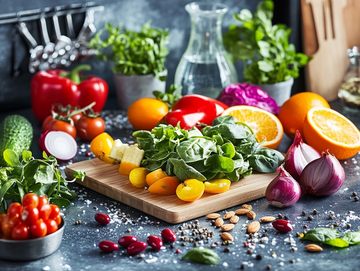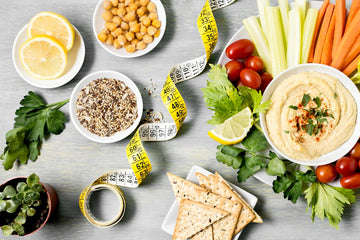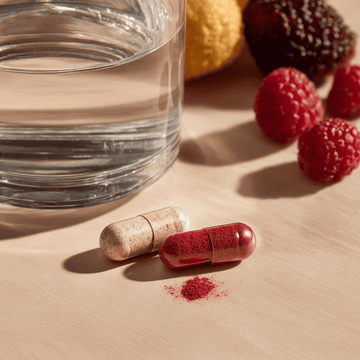Do you need more potassium?
Do you want to know how to recognize potassium deficiency, how much potassium you need and which potassium foods reliably supply you?
In brief: Potassium is an essential electrolyte for nerves, muscles, and the heart. Depending on the source, recommended daily values are approximately 3,500–4,000 mg. Signs of a deficiency can include fatigue, muscle cramps, or heart palpitations, often triggered by heavy sweating, diarrhea/vomiting, diuretic medications, or a very high-salt, low-plant diet. The fastest way to replenish your stores is through potassium-rich foods such as potatoes, legumes, leafy greens, avocados, bananas, (dried) apricots, and nuts. Below you'll find a practical list, preparation tips, and daily examples.
What is potassium and why is it so important?
Potassium is a mineral and, as an electrolyte, is essential for:
- the fluid balance within the cells,
- the conduction of nerve excitation,
- muscle contraction, including heart muscle,
- blood pressure regulation (especially in relation to sodium).
Your body cannot produce potassium itself; you depend on the daily intake from potassium foods.
Daily requirement: How much potassium per day?
Depending on the source, approximately 3,500–4,000 mg of potassium per day is recommended for adults. Individual needs may increase with strenuous physical activity, excessive sweating, persistent digestive problems, or certain medications (e.g., diuretics).
Important: If you have impaired kidney function or are taking potassium-sparing medication, you should consult your doctor before taking a higher potassium intake, as too much can be problematic.
Causes & symptoms of a potassium deficiency
Possible causes:
- Low dietary intake (few vegetables/fruit, few whole foods)
- High losses due to sweating, diarrhea, vomiting
- Medications (e.g. diuretics, certain laxatives)
- Very salty diet (a lot of sodium shifts the balance)
- Alcohol consumption, chronic stress, crash diets
Common symptoms of potassium deficiency (non-specific, consult a doctor!) :
- Muscle weakness, cramps, tremors
- Fatigue, lack of motivation, concentration problems
- Heart palpitations, irregular pulse
- Digestive problems (e.g. constipation)

The 15 best potassium foods
The following potassium foods are practical, versatile, and easy to combine. Amounts are rough guidelines per 100g or typical serving to help you get a feel for them (numbers may vary depending on the variety/crop):
1. Potatoes (boiled, with skin): very rich in potassium; as baked potatoes, jacket potatoes, potato salad
2. Sweet potatoes: similarly strong; ideal in the oven, as wedges or mashed potatoes
3. Pulses (white beans, lentils, chickpeas): great for bowls, curries, stews
4. Spinach & chard (blanched/steamed): high in potassium, plus iron & folate
5. Avocado: rich in potassium & monounsaturated fatty acids
6. Bananas: classic, practical for on the go and after training
7. (Dried) apricots: very concentrated; as a snack or in muesli
8. Tomatoes & tomato paste: fresh, as a sauce or in soups
9. Mushrooms (champignons, porcini mushrooms): in pan and oven dishes
10. Nuts (almonds, pistachios) & seeds (sunflower seeds): snack, topping
11. Beetroot: as oven-baked vegetables or carpaccio
12. Cabbage varieties (broccoli, savoy cabbage): plus fiber & phytochemicals
13. Oranges & orange juice: fruity option (juice in moderation)
14. Yogurt/quark: moderate contribution, good combination with fruit/nuts
15. Fish (e.g. salmon): provides additional protein & Omega-3
Practical tip: Combine several potassium-rich foods per meal, e.g., chili sin carne (beans + tomatoes + peppers) with a baked potato or a lentil curry with spinach and sweet potato.
Preparation & Bioavailability: How to get more potassium from your food
- Reduce water consumption: Potassium is water-soluble. Steam or oven cook instead of boiling in a lot of water.
Use cooking water: When you cook, use cooking water for soups or sauces, for example, to retain some of the potassium.
- Fresh & ripe: Ripe fruit/vegetables often have more flavor, so you automatically eat larger portions.
- Leave the skin on: With potatoes and the like (wash well), there are more micronutrients under the skin.
- Salt-potassium balance: Less sodium (table salt) promotes the effect of potassium on blood pressure.

Correct potassium deficiency: nutrition first, sensible supplementation
The first choice against potassium deficiency is potassium foods in every meal:
- Breakfast: Yogurt/quark with bananas, apricots, nuts; or porridge with dried fruit and seeds
- Lunch: Baked potatoes + spinach/kale + beans/tomatoes
- Evening: Lentil dal with sweet potato & chard; whole-grain bread with avocado & tomato
Practical booster : A smoothie made from spinach, banana, (orange) juice, and water. For more satiety and protein, our vegan protein powder is perfect for green smoothies, making the meal more complete without diluting potassium intake with potassium-rich ingredients.
During exercise: If you sweat a lot, make sure you also drink plenty of fluids and electrolytes. Our MTM Amino Acids + Electrolytes can support you throughout your training (amino acids for performance/recovery, electrolytes for hydration). Note: This is not a potassium supplement; check the nutritional information if necessary, and consult your doctor if you have any medical questions.
Risks & Interactions: When caution is advised
- Kidney disease: If kidney function is impaired, too much potassium (hyperkalemia) can be dangerous; seek medical advice.
- Medications: ACE inhibitors, ARBs, potassium-sparing diuretics, etc. can increase potassium; adjust dosage and diet.
- Supplements & salt substitutes: Use potassium-containing food supplements or potassium salt (salt substitutes) only specifically and after consultation.
- Warning signs: Persistent cardiac arrhythmia, severe muscle weakness, feelings of paralysis → seek medical advice immediately.
3 simple daily examples for more potassium
Example 1: Plant-based & fast
- Breakfast: Porridge with banana, apricots, almonds
- Lunch: Baked potatoes with spinach and tomato sauce
- Snack: Oranges & Yogurt
- Evening: Lentil soup with carrots, celery, tomatoes
Example 2: Office day with bowl
- Breakfast: Quark with berries & sunflower seeds
- Lunch: Bowl of chickpeas, avocado, beetroot, broccoli, whole grain
- Snack: Handful of pistachios
- Evening: Sweet potato tray with mushrooms and herb curd
Example 3: Training focus
- Before training: banana + water
- After training: Green smoothie (spinach, banana, orange juice) + MTM vegan protein powder
- Evening: Chili sin Carne (beans + tomatoes) with baked potato

FAQ
How do I know if I have a potassium deficiency?
Typical symptoms include muscle weakness, cramps, fatigue, or heart palpitations. These symptoms are non-specific; please seek medical advice, especially if symptoms are severe.
How quickly can I correct a potassium deficiency?
Mild deficiencies can often be improved within a few days with potassium-rich meals. Severe deficiencies or underlying diseases require medical attention.
What are the best potassium foods for on the go?
Bananas, dried apricots, nuts/pistachios, and oranges. Practical: a roasted chickpea snack or a whole-grain avocado sandwich.
Does potassium lower blood pressure?
A diet rich in potassium and low in sodium can have a positive effect on blood pressure. The overall package (vegetables/fruit, whole grains, exercise) is important.
Do I need potassium tablets?
Generally, no. Potassium foods should be taken first. Supplements should only be taken when clearly needed and after consulting a doctor, especially if you have kidney problems or are taking medication.
Conclusion
Potassium foods are the safest, most sustainable way to avoid or gently compensate for a potassium deficiency. Eat vegetables, legumes, potatoes, fruit, and nuts daily, and optimize your preparation to ensure the potassium stays on your plate.
If you want support for training and recovery, try amino acids + electrolytes around your workout or supplement your smoothie with vegan protein powder for more satiety.




